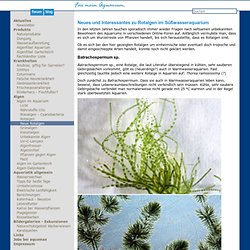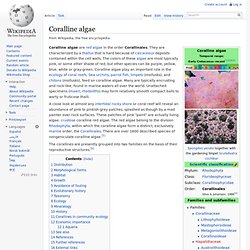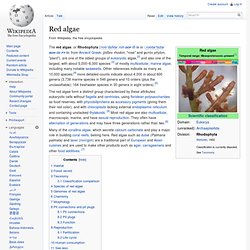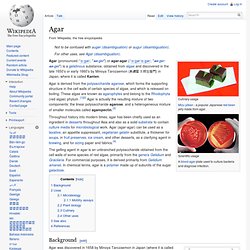

Bangia. Bangia atropurpurea. Batrachospermum. In den letzten Jahren tauchen sporadisch immer wieder Fragen nach seltsamen unbekannten Bewohnern des Aquariums in verschiedenen Online-Foren auf.

Anfänglich vermutete man, dass es sich um Wurzelreste von Pflanzen handelt, bis sich herausstellte, dass es Rotalgen sind. Ob es sich bei den hier gezeigten Rotalgen um einheimische oder eventuell doch tropische und damit eingeschleppte Arten handelt, konnte noch nicht geklärt werden. Batrachospermum sp. Batrachospermum gelatinosum.
Porphyra. Life cycle[edit] Porphyra displays a heteromorphic alternation of generations.[4] The thallus we see is the haploid generation; it can reproduce asexually by forming spores which grow to replicate the original thallus.

It can also reproduce sexually. Both male and female gametes are formed on the one thallus. The female gametes while still on the thallus are fertilized by the released male gametes, which are non-motile. Porphyra purpurea (Roth) C.Agardh. Porphyra purpurea. Porphyra purpurea Helgoland. Coralline algae. Coralline algae are red algae in the order Corallinales.

They are characterized by a thallus that is hard because of calcareous deposits contained within the cell walls. The colors of these algae are most typically pink, or some other shade of red, but other species can be purple, yellow, blue, white or gray-green. Coralline algae play an important role in the ecology of coral reefs. Sea urchins, parrot fish, limpets (mollusks), and chitons (mollusks), feed on coralline algae. Many are typically encrusting and rock-like, found in marine waters all over the world. The corallines are presently grouped into two families on the basis of their reproductive structures.[6] Distribution[edit] Coralline algae are widespread in all of the world's oceans, where they often cover close to 100% of rocky substrata.
Morphological forms[edit] Corallines have been divided into two groups, although this division does not constitute a taxonomic grouping: Seaweed Industry Association. Corallina officinalis. Corallina. Species[edit] Corallina armata J.D.Hooker & Harvey, 1847Corallina berteroi Montagne ex Kützing, 1849Corallina binangonensis Ishijima, 1944Corallina ceratoides KützingCorallina confusa Yendo, 1902Corallina cuvieri J.V.Lamouroux, 1816Corallina densa (Collins) Doty, 1947Corallina elongata J.Ellis & Solander, 1786Corallina ferreyrai E.Y.Dawson, Acleto & Foldvik, 1964Corallina frondescens Postels & Ruprecht, 1840Corallina goughensis Y.M.Chamberlain, 1965Corallina hombronii (Montagne) Montagne ex Kützing, 1849Corallina millegrana Lamarck, 1815Corallina muscoides Kützing, 1858Corallina officinalis Linnaeus, 1758Corallina panizzoi R.Schnetter & U.Richter, 1979Corallina pilulifera Postels & Ruprecht, 1840Corallina pinnatifolia (Manza) Dawson, 1953Corallina polysticha E.Y.Dawson, 1953Corallina vancouveriensis Yendo, 1902.

Red algae. The red algae, or Rhodophyta (/roʊˈdɒfɨtə/ roh-DOF-fit-tə or /ˌroʊdəˈfaɪtə/ ROH-də-FY-tə; from Ancient Greek: ῥόδον rhodon, "rose" and φυτόν phyton, "plant"), are one of the oldest groups of eukaryotic algae,[2] and also one of the largest, with about 5,000–6,000 species [3] of mostly multicellular, marine algae, including many notable seaweeds.

Other references indicate as many as 10,000 species;[4] more detailed counts indicate about 4,000 in about 600 genera (3,738 marine species in 546 genera and 10 orders (plus the unclassifiable); 164 freshwater species in 30 genera in eight orders).[5] Habitat[edit] Most rhodophytes are marine, although freshwater species are found; these generally prefer clean, running water, but with some exceptions.[8] Fossil record[edit] One of the oldest fossils identified as a red alga is also the oldest fossil eukaryote that belongs to a specific modern taxon. Red algae are important builders of limestone reefs. Agar. Scientific usage A blood agar plate used to culture bacteria and diagnose infection.

Agar (pronounced /ˈɑːɡər/, "AH-gər") or agar-agar (/ˈɑːɡərˈɑːɡər/, "AH-gər-AH-gər") is a gelatinous substance, obtained from algae and discovered in the late 1650's or early 1660's by Minoya Tarozaemon (美濃屋 太郎左衛門) in Japan, where it is called Kanten. Agar is derived from the polysaccharide agarose, which forms the supporting structure in the cell walls of certain species of algae, and which is released on boiling. These algae are known as agarophytes and belong to the Rhodophyta (red algae) phylum .[1][2] Agar is actually the resulting mixture of two components: the linear polysaccharide agarose, and a heterogeneous mixture of smaller molecules called agaropectin.[3] The gelling agent in agar is an unbranched polysaccharide obtained from the cell walls of some species of red algae, primarily from the genera Gelidium and Gracilaria.
Background[edit] The structure of an agarose polymer. Uses[edit] Agar is used: